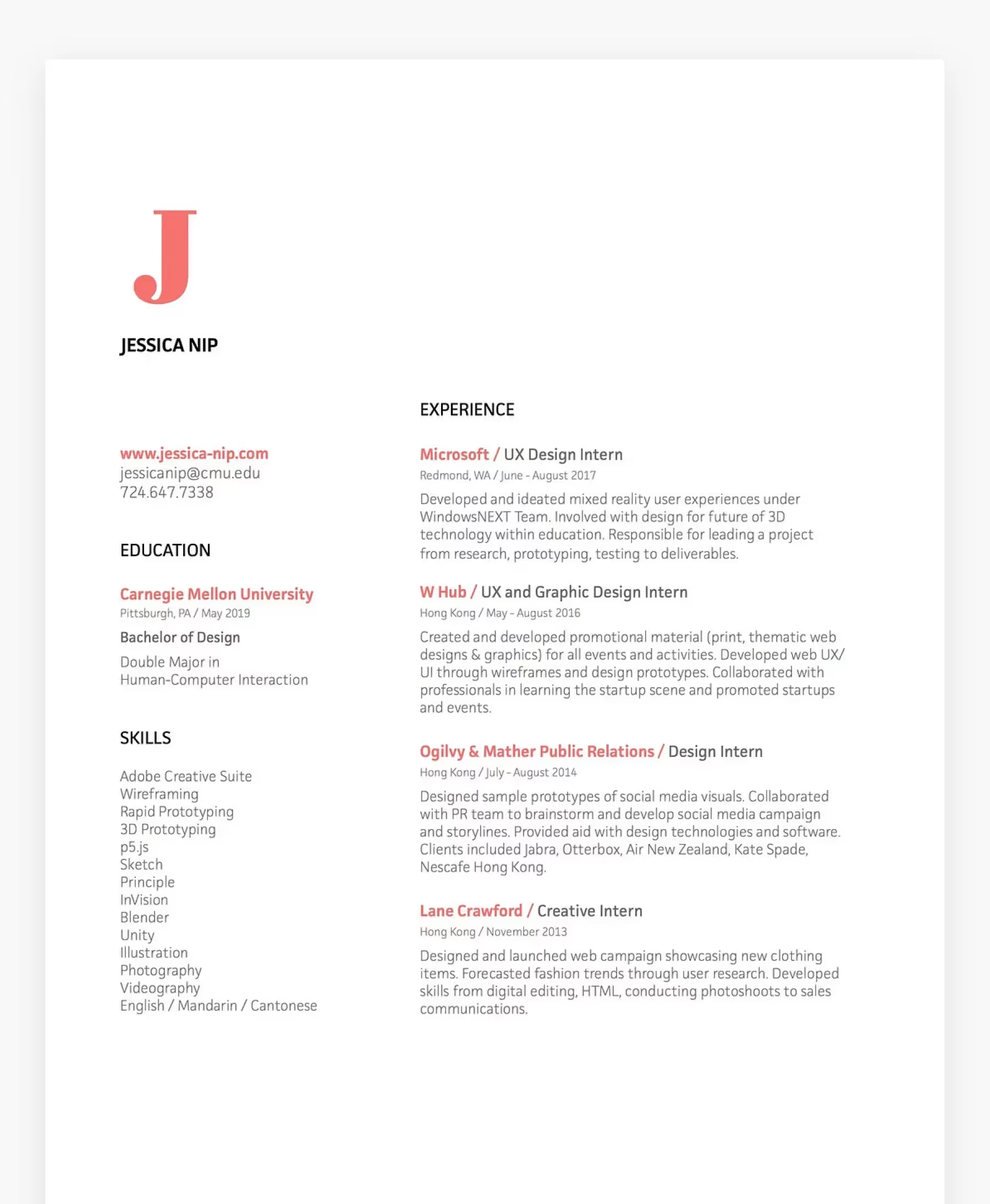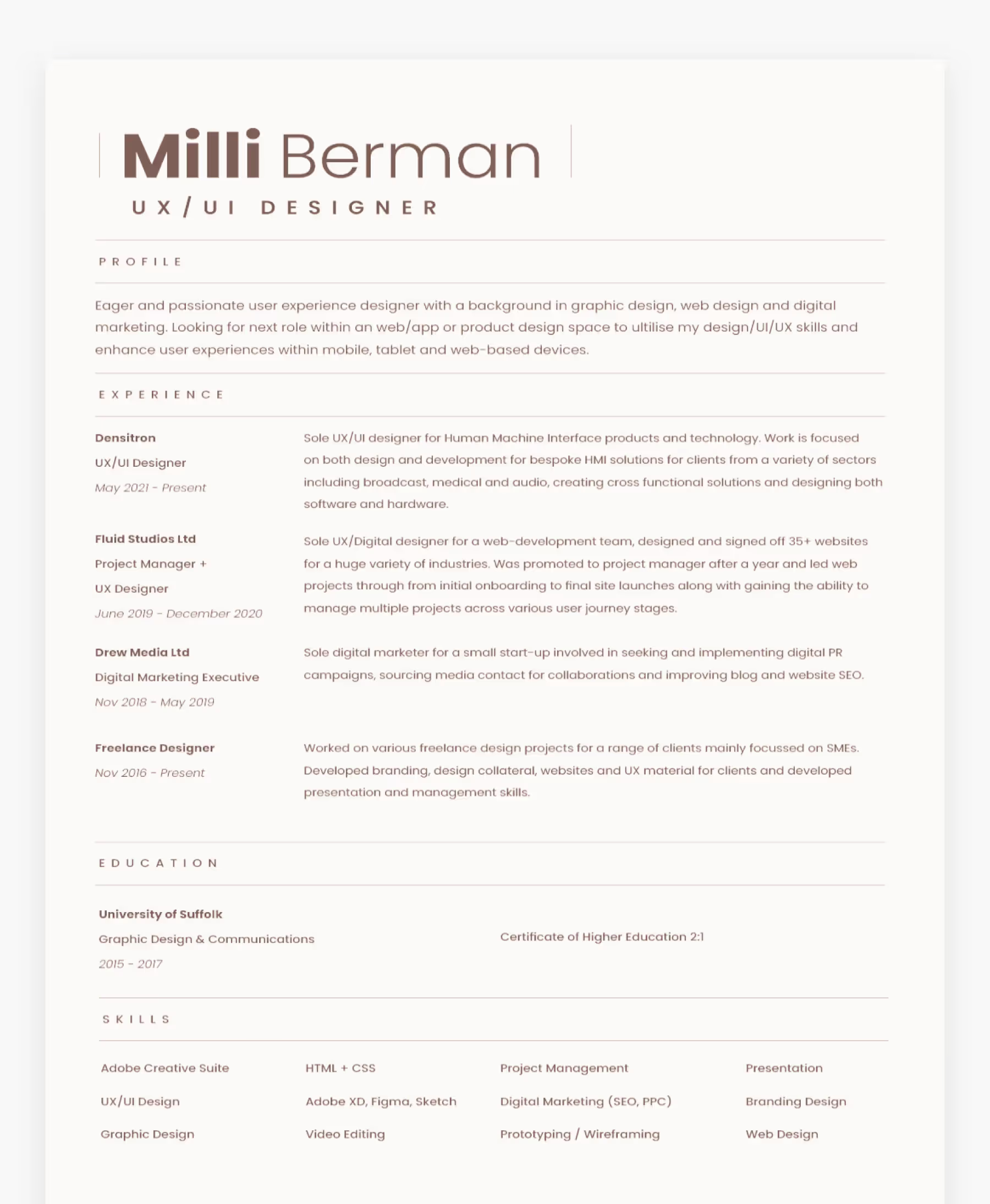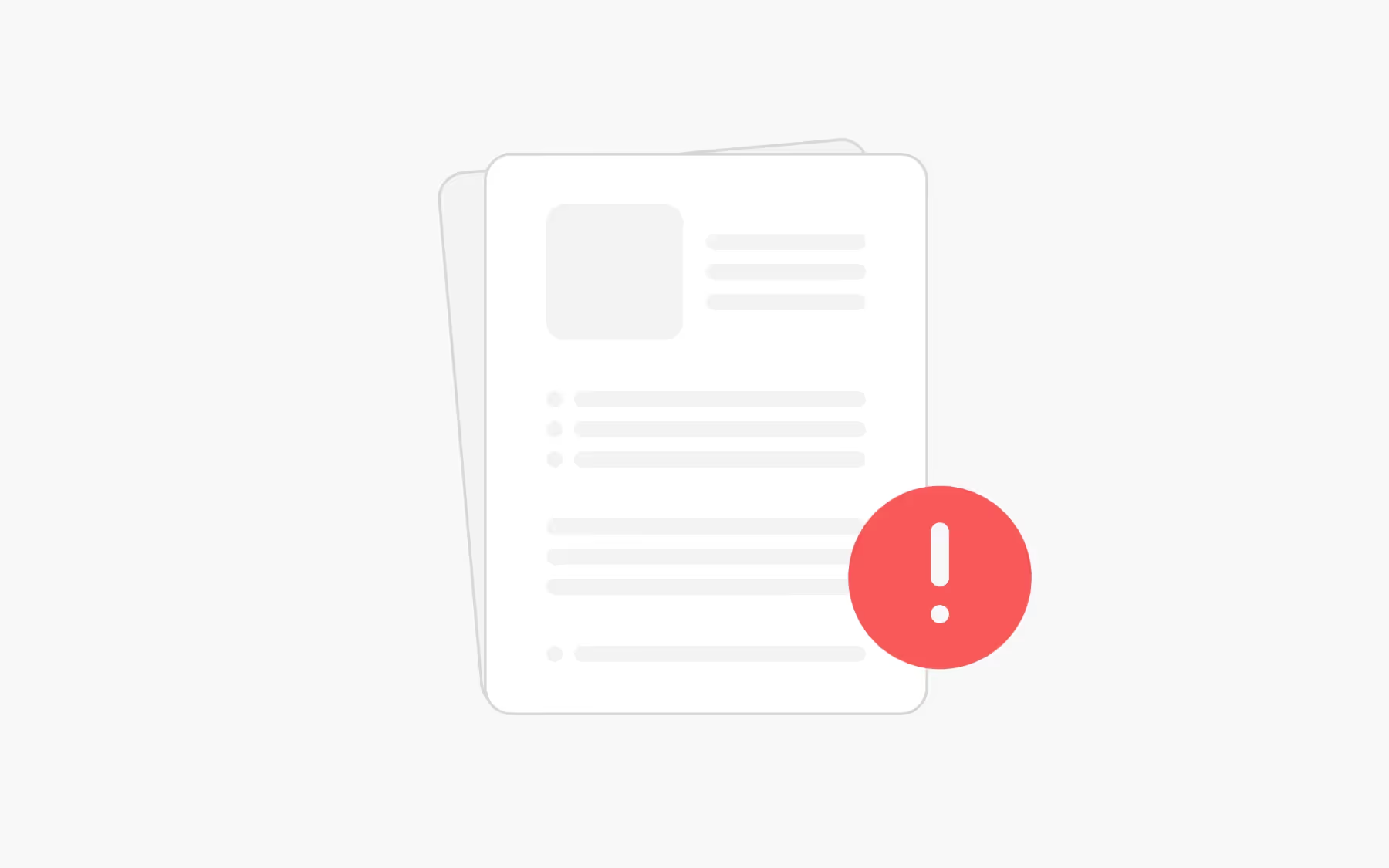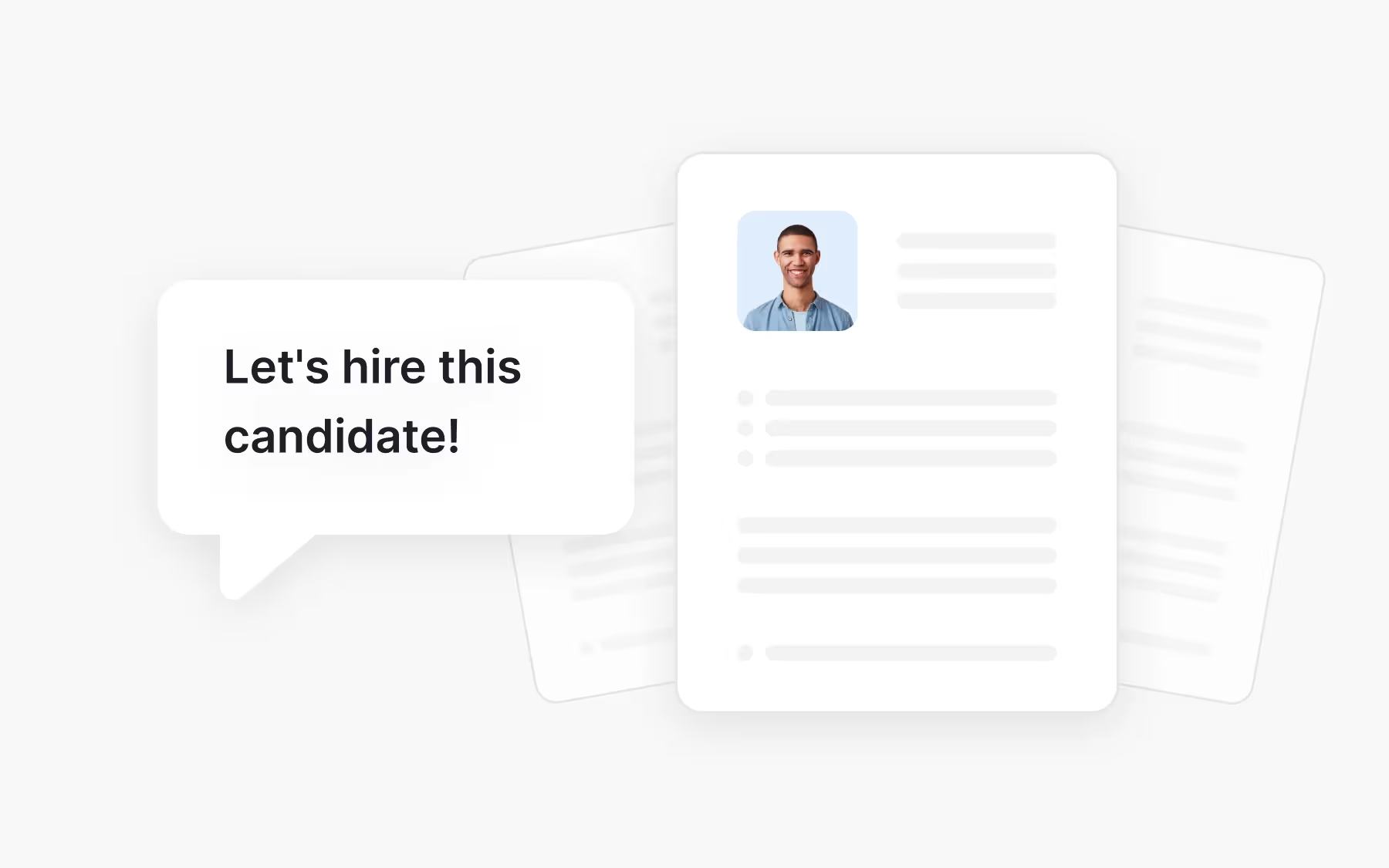
You might think a portfolio is all you need when applying for UX design jobs. While it’s definitely important, UX designers also need a strong resume to share deeper insights into their experience, education, and skills.
A comprehensive resume that makes you stand out from the crowd hugely increases your chances of landing your dream job. It provides hiring managers with all the details they need to make a hiring decision. Making your resume visually striking is essential to capture the hiring manager's attention, so consider your color scheme, bolding, and formatting to ensure your application stands out.
This UX designer resume guide will equip you with the tools you need to create a killer resume—as well as ten examples to learn from. Compelling storytelling in your resume and case studies can help you stand out by engaging readers and effectively illustrating your expertise.
Let’s start with the basics.
Introduction to UX designer resumes
Look, crafting a solid UX designer resume isn't just some checkbox exercise—it's your way of cutting through the noise in today's brutal job market. Sure, your portfolio shows off your design chops and creative process, but let's be real: your resume is what hiring managers actually look at first. It's the thing they scan in about ten seconds to figure out if you're worth their time. A killer UX designer resume doesn't just dump your work history on a page—it tells them exactly why you're the designer they've been looking for.
Here's what actually matters when you're putting this thing together: clean contact info that doesn't make them hunt for your email, a personal statement that doesn't waste words, your work experience laid out in reverse order so they see your latest wins first, your education, and a skills list that actually connects to what they need. Every single section needs to speak to that specific job posting. You can't just blast the same resume everywhere and hope something sticks. Remember, these hiring managers are flipping through dozens of resumes, probably while drinking their third coffee of the day. Your resume better be easy to scan, look good, and pack the most important stuff right up front. Do this right, and you're not just getting noticed—you're getting that interview that lands you exactly where you want to be.
What is a UX designer resume? And how does it differ from standard resumes?

A UX designer resume is a concise document detailing a designer’s experience, technical skills, education, and more. It’s a document designed to convince a hiring manager why you’re a great UX designer. A resume is usually accompanied by a cover letter and a portfolio showcasing your best UX skills. Be sure to include a link to your online portfolio or dedicated portfolio website on your resume, as this allows hiring managers to easily review your work and assess your capabilities.
A UX designer resume is different from a standard resume in that you won’t get away with poor design. Your UX designer resume needs to be well-put-together and designed in line with your portfolio and cover letter. Where poor design isn’t the end of the world for standard resumes, missing the mark with a UX designer resume contradicts all the skills listed on the document. If you can’t design a strong resume, how will you design strong products?
You might include a couple of personal details in your UX design portfolio, but your resume is where you really get into that personal information. Your portfolio should highlight your top skills as a UX designer, and your resume should tell hiring managers the work experience, qualifications, and education that helped you get there. For entry-level designers, including personal projects can help demonstrate initiative and practical skills, giving hiring managers insight into your real-world experience. You want to be succinct, as a UX designer resume is typically a single-page document.
Let’s have a look at what hiring managers tend to look for when seeking UX designers.
Note: Always save and share your resume as a PDF rather than editing in Microsoft Word to ensure formatting consistency and avoid errors.
Understanding the job description
When I started applying for UX design roles, I quickly learned something that changed everything. You can't just send the same resume everywhere. That never worked. Hiring managers use job postings like checklists. They're looking for specific skills, specific experience. As a UX designer, you have to show them you get it. You understand exactly what they need.
So I started doing this differently. I'd read every job description like it was a puzzle to solve. What skills were they really asking for? What responsibilities mattered most? Then I'd tailor my resume to match. If they wanted user research and usability testing, those went front and center. Supported by real examples from my career. I'd highlight the technical stuff too - Figma, Adobe XD, user interviews. Whatever they mentioned, I made sure it was there. Visible. Relevant.
Here's what I discovered: when you customize your resume for each application, something shifts. You're not just another applicant anymore. You're showing hiring managers that you actually read their posting. That you care about this specific role. That you're not mass-applying to everything. This targeted approach? It works. I started getting more interviews. More callbacks. Eventually, I landed roles I actually wanted. The dream jobs in UX design became real possibilities.
What hiring managers are looking for in a UX designer's resume
In addition to the more general information, which we’ll go into later, a model UX designer resume must show three things:
- Relevant UX experience and expertise
- High-quality technical skills and knowledge of design tools
- A very strong understanding of UX and the role of design
Many hiring managers are actively looking for reasons to reject candidates during the initial screening, so it's crucial to clearly highlight all necessary skills relevant to the job description, such as user research, wireframing, and UI/UX design.
Keep these central goals in mind when creating your UX designer resume, and remember to gear every single detail towards getting these across. Understanding the hiring process and how resumes are evaluated at each stage can help you tailor your resume to pass through initial screening stages. Now we’ve been through some of the details, let’s dive into some UX designer resume examples to help inspire your own UX designer resume.
10 Examples of winning UX designer resumes and why they work
Let’s take a look at these requirements in practice with this list of top-notch example resumes. As you review each example, pay close attention to key points such as formatting, skill emphasis, and unique design choices—notice how varying font weights, fonts, and shades are used to highlight important information and improve readability. Sometimes the best inspiration comes from having a clear idea of what kind of end product you want to create.
1. The traditional entry-level UX designer resume

Key takeaways from this UX design resume: this candidate is searching for their first full-time position as a junior UX designer, and so has little relevant experience for the role.
However, they have completed an internship in UX design, and they’ve successfully focused on this—fleshing it out to emphasize it to hiring managers.
If you’re looking to break into the industry, this is a great example of a UX designer resume template. Entry-level candidates can also highlight their ability to conduct user research, even if this experience comes from coursework or personal projects.
2. The concise entry-level UX designer resume

Key takeaways from this UX design resume: this is a clear, to-the-point resume that demonstrates experience in the industry. It’s easy to read and to navigate—no fuss. The concise format also helps save space, making the resume more efficient and easier to read.
One thing this resume does lack, however, is a short biography. There’s little personality, and while that’s not essential, it can be a nice addition. This resume sticks to the bare-bone basics: education, experience, and skills.
3. The clear entry-level UX designer resume

Key takeaways from this UX design resume: the larger headers for each section makes it easy to scan this document for key information. .
The resume also includes projects, which is a good opportunity to tailor the resume to different roles. If you’ve done similar projects to what’s being asked in a JD, share them! Using compelling storytelling in your project descriptions can help engage hiring managers and better illustrate your expertise.
4. The bold interdisciplinary UX designer resume

Key takeaways from this UX design resume: this resume successfully balances white space with plenty of information. The ‘Ask me about' section gives a glimpse into the applicant's interests and personality: we'd advise adapting the tone and content of the section to each company you apply for. Some will appreciate its casual nature, others may prefer a more professional tone.
5. The colorful junior UX designer resume

Key takeaways from this UX design resume: the color splash at the top is subtle and professional, yet still draws the eye.
You'll notice that the personal bio is at the end of the document. It's very succinct and acts as a great signpost to his general profile, so we'd advise moving it up to the top, where it's more noticeable.
6. The segmented senior UX designer resume

Key takeaways from this UX design resume: this resume stands out by successfully balancing engaging and professional language. It uses an original format that segments information with line breaks—creating blocks for related information.
The bolded, colorful headings also make it easy to identify and distinguish between segments—creating a skimmable CV. This segmented format is especially effective for senior designers who want to showcase their career progression, including leadership roles, promotions, and expanding responsibilities.
7. The organized senior UX designer resume

Key takeaways from this UX design resume: this resume stands out for its clear organization and professional format. It uses bolding and italics, and to optimize readability while maintaining the same font and color.
8. The experienced senior UX designer resume

Key takeaways from this UX design resume: this resume stands out because of the way that the applicant, a senior UX designer, has presented their impressive track record.
The format means that achievements are clearly visible—no words are wasted and the writing is exceptionally to-the-point. The resume effectively highlights experiences where the candidate led teams and worked with leading tech companies, demonstrating both leadership and industry credibility.
9. The comprehensive senior UX designer resume

Key takeaways from this UX design resume: this resume stands out for the personal branding and consistent typography. The format is easily readable and organized so that hiring managers can hone in on experience and accomplishments first. Including key skills such as information architecture and interaction design can further strengthen the resume and appeal to hiring managers.
However, we’ve got two suggestions:
- Rethink the Skills section to include skill prioritization and bullet points. The list is very long and chunked together into one block of text that doesn’t highlight any skills in particular.
- Remove the extra spacing in the experience section. The current resume includes inconsistent spacing from one role to the next, which could imply a large gap between roles. Looking at the dates shows no such gap, so amend the spacing to reflect this.
10. The eye-catching senior UX designer resume

Key takeaways from Ryan Tinsley's UX design resume: the dark background and white text are an original touch, and will grab the hiring manager's attention. The bolding and formatting are consistent throughout, and make this resume easy to read and scan.
An all-black resume is a bold and memorable choice, but it's not for every position. Consider the company you're applying to, and whether they're interested in originality.
A writing guide for UX design resumes
Now we’ve looked at some examples, let’s take a deeper dive into what exactly you need to be including in your UX design resume.
When presenting your achievements, try to quantify your impact wherever possible. For example, you can use established metrics like the System Usability Scale (SUS) to demonstrate improvements in user satisfaction and system effectiveness.
Don’t forget to highlight your soft skills. In addition to communication and collaboration, time management is an important soft skill for UX designers to showcase, especially if you’re new to the field or transitioning from a related role.
What is included in a UX designer resume?

Remember when we said we’d be coming back to the exact details shortly. We’re here, let’s take a look at how to craft a winning UX design resume.
- Name and contact information
Add your personal details front and center, so that hiring managers can easily identify your personal information and contact details. We’d advise including your email address, phone number, and hyperlinked LinkedIn profile.
If you’re submitting a physical copy of your resume you’ll likely need to tweak this section to remove any links. However, modern-day recruiting usually takes place online—so including links enables you to share more information.
🧠 Uxcel top tip: You can add a link to your Uxcel profile to give hiring managers another way to validate your UX design skills. Uxcel profiles include your Skills Graph and specific design skill certificates—and can even be built out to include contact information, work experience, and more.
- Personal statement
No more than three or four lines long, this is where you provide a very brief summary of yourself. Keep it short and sweet, and avoid including unnecessary details.
For example:
Passionate and highly skilled UX designer and product designer specializing in graphic design, web design, and usability testing. Seeking a freelance role in a project design space to use considerable UX/UI design skills and enhance user experience in mobile, tablet, and web-based devices.
- Work experience
Write this in reverse order. If you’re an entry-level UX designer and you’re applying for your first job, don’t panic. You can include information about any internships you may have completed, a school/university UX design project, or any other organizations you’ve worked with.
All experiences should include two to three lines explaining what you did, and how it helped you develop relevant skills. Stats and specific program names are important to emphasize credibility.
For example:
Senior Product Designer at Uxcel, San Francisco, 2019-2022
- Re-designed internal web and mobile apps to increase sign ups by 39%
- Designed and developed responsive and adaptive websites using HTML5 and CSS3
- Improved load speed on website from 2 seconds to 0.8 seconds by applying recommendations from Google Lighthouse
- Education
Start with your most recent educational program and work backwards. Don’t worry if it’s not directly relevant—an employer might see a career change as a show of your commitment to UX design, and your range of experience can make you a stronger candidate.
For example:
B.S. in Computer Science, Stanford University, San Francisco, 2010-2014
- Distinction in UX Design and UI Development coursework
- Completed a UX thesis project: Intercultural Design: Designing for Different Regions
- Skills
Select your most relevant skills for the role in question and list them in order of importance. You also want to include the tools you use here, as tool proficiency is often a sought-after skill for UX design positions.
If your list is looking slightly short, you can work to improve your UX design skills by completing online courses and tests to get those skills up to scratch. Uxcel’s online UX design courses are a great resource for developing specific skills and improving overall.
Here’s an example of some of the skills you could include in your resume:
- Prototyping
- Usability testing
- User testing
- HTML 5, JavaScript, CSS
- User research
- Design flow creation
- Awards and recognitions
This section isn’t compulsory, but it’s a good opportunity to show off about any relevant recognition or certificates you’ve previously received. These may be certificates of course completion, professional UX design certifications, industry awards, or more. You may also want to include a Further Information section if you have other proficiencies (for example, proficiency in various languages) you want to include.
For example:
- UX Designer Certification
- Mobile Design at Uxcel, 2025
- Typography in UX UI Design at Uxcel, 2025
- Google UX Design Professional Certification, 2019
- Top-rated UI Design Tutor on Tutorfair, 2018
Let’s take a closer look at some of the key skills you’ll want to show on your resume.
Most Important Skills to Display on Your Resume
First you've got the hard skills that hiring managers will be looking for:
- User research
- Wireframing
- Prototyping
- Usability testing
- Design accessibility
- Typography
Then you've got soft skills to boost your resume:
- Communication
- Problem-solving skills
- Teamwork
- Determination
- Initiative
And finally, tool skills to include:
- Figma
- Sketch
- Maze
- AdobeXD
- Adobe Illustrator
Looking to learn and improve your design skills and bulk up your resume? Get started with Uxcel and complete interactive UX courses and skills tests created for professional designers.
Formatting your UX resume the right way
There is no definitive 'right' way to format your UX designer resume—you can see that in the variety of the example resumes we've just been through. However, there are general best practices to keep in mind.
Here are our top tips for formatting your resume:
- Cut the fluff and keep it to one page.
- Format your education, employment, and experience in reverse chronological order.
- Select a professional, easy-to-read font and set it to size 10, 11 or 12. No smaller, no larger (except your name at the top of the resume, which must stand out in big, bold lettering).
- Bullet points are fine, even recommended, but stick to standard, circular bullet points.
- Ensure your text spacing and punctuation is consistent—either use full stops at the end of your bullet points or don't, but stick to one.
- White space is important: no one wants to read a page of solid text.
- Use the format to highlight your most impressive achievements or experience, and those that best match the job description.
So, that's what you should do, now let's look at what you shouldn't do.
Avoid these common mistake

Competition is tight, so consider these top five, most common resume errors when creating your resume.
- Bad grammar and spelling mistakes. Claiming you've got ‘an exceptional eye for detail' or similar doesn't hold much weight if you submit an error-ridden resume. Always find and fix potential typos by scanning your resume text through an AI grammar checker.
- Don't use a skill scale. These are becoming increasingly trendy in the UX design resume world—used by applicants to rate their skill level on a scale of one to five—but they make little sense. For example, if you score yourself 5/5 for Adobe Photoshop, are you saying you're an expert and you have nothing else to learn?
- Avoid using default resume templates found online. Starting with a template is fine, but you definitely want to add some personality to ensure it doesn't match another applicant.
- Test your links. Having your LinkedIn and portfolio as clickable links on your resume is a great idea, as it'll save recruiting managers an extra step. Ensure they work—test your links.
- Check whether you need a password to gain access to your UX design portfolio, and if so include it in big letters at the top of your resume. Rather than chasing you up for the information, time-pressed hiring managers are much more likely to simply skip your portfolio if they can't get access, which almost certainly means rejection.
We've also got some bonus tips to ensure your resume is top-notch—take a look.
Bonus tips to make your resume stand out from competitors

If you want to land that job you’ll need to go above and beyond. Let’s take a look at our four top tips to help you impress those recruiters with a high-quality resume.
- Tweak it to the job you’re applying for: each role has different requirements, tweak your resume to highlight your skills that match those requirements.
- Consider getting a UX Designer Certification: Uxcel’s role-specific UX certifications are industry-recognized certifications that validate your skills and knowledge for a variety of UX roles, including UX designer.
- Make it yours: you’re applying to be a designer, so let your design personality shine through.
- Have someone else look it over: having another pair of eyes look over your work is crucial to spot small mistakes.
There are also specialized tools and resources available for UX professionals, such as portfolio builders and resume templates tailored to their needs, which can help create standout applications.
Half the battle is preempting the common shortcomings that hiring managers watch out for. If you make sure you’ve got every base covered, you’ll significantly increase your chances of getting hired.
So…
You’ve got your UX resume, now what?
As we mentioned earlier, a UX design resume will go hand-in-hand with a cover letter and design portfolio. .
- A cover letter is essentially a pitch that proves why you'd be a good fit for the role and company. Include an introduction detailing your experience highlights, a paragraph on why you fit the job description, and a conclusion that expresses your interest and enthusiasm for the role.
- A portfolio is where you showcase your skills and previous work. Crafting the perfect portfolio is about quality not quantity, and about demonstrating your design experience and process to prospective clients and employers. If you're an entry level designer with little experience, try taking UX challenges and skills tests to create designs to include in your portfolio.
To really impress recruiters, remain consistent across the three documents. Use the same color palette and typography to create a memorable personal aesthetic and style.
Once you've got a strong resume, cover letter, and portfolio—you're ready to start applying for positions. Uxcel's Job Board is a great place to find UX roles with top businesses—such as Lululemon, Siemens, and more. Then, all that's left is to prepare for the UX designer interview stage.
Develop your skills and enhance your resume with Uxcel
Recruiters look at your CV for an average of 7.4 seconds before moving on—so you want to make sure they've got an easy path to your top qualifications, experience, and skills.
Standing out requires a well-put-together resume that gets straight to the point. It should demonstrate your UX proficiency and expertise as well as your relevant experience in the field.
If you're looking to bulk up your UX designer resume with relevant certificates and case studies, try Uxcel. The online UX courses are a great way to improve your skills, and issue a certificate of completion upon finishing a course—which you can include in your resume. You can also take UX certification assessments to gain credibility as a UX designer when applying for positions.
Ready to join the world's biggest design community and start honing your skills? Get started with Uxcel today.




